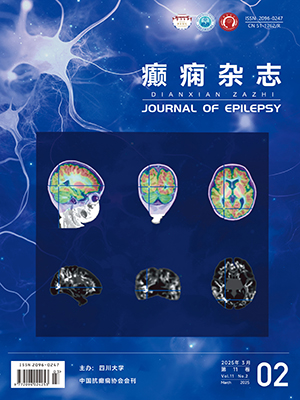| 1. |
Bien CG, Widman G, Urbach H, et al. The natural history of Rasmussen’s encephalitis. Brain, 2002, 125(Pt 8): 1751-1759.
|
| 2. |
Pardo CA, Vining EPG, Guo L, et al. The pathology of Rasmussen’s syndrome: stages of cortical involvement and neuropathological studies in 45 hemispherectomies. Epilepsia, 2004, 45(5): 516-526.
|
| 3. |
陈帅, 王一松, 关宇光, 等. Rasmussen脑炎的病因及发病机制研究现状. 转化医学电子杂志, 2015, 2(10): 121-125.
|
| 4. |
Xinghui He, Fan Chen, Yifan Zhang, et al. Upregulation of adenosine A2A receptor and downregulation of GLT1 is associated with neuronal cell death in Rasmussen's encephalitis. Brain Pathol, 2020, 30(2): 246-260.
|
| 5. |
Bien CG, Granata T, Antozzi C, et al. Pathogenesis, diagnosis and treatment of Rasmussen encephalitis: a European consensus statement. Brain, 2005, 128(Pt 3): 454-471.
|
| 6. |
Bhatjiwale MG, Polkey C, Cox TC, et al. Rasmussen’s encephalitis: neuroimaging findings in 21 patients with a closer look at the basal ganglia. Pediatr Neurosurg, 1998, 29(3): 142-148.
|
| 7. |
Leach JP, Chadwick DW, Miles JB, et al. Improvement in adult-onset Rasmussen’s encephalitis with long-term immunomodulatory therapy. Neurology, 1999, 52(4): 738-742.
|
| 8. |
Gray F, Serdaru M, Baron H, et al. Chronic localised encephalitis (Rasmussen’s) in an adult with epilepsia partialis continua. J Neurol Neurosurg Psychiatry, 1987, 50(6): 747-751.
|
| 9. |
Hart YM, Andermann F, Fish DR, et al. Chronic encephalitis and epilepsy in adults and adolescents: a variant of Rasmussen’s syndrome? Neurology, 1997, 48(2): 418-424.
|
| 10. |
Cay-Martinez KC, Hickman RA, McKhann Ii GM, et al. Rasmussen encephalitis: an update. Semin Neurol, 2020, 40(2): 201-210.
|
| 11. |
Ambrosino P, Freri E, Castellotti B, et al. Kv7. 3 compound heterozygous variants in early onset encephalopathy reveal additive contribution of C-terminal residues to PIP2-dependent Kt channel gating. Mol Neurobiol, 2018, 55(08): 7009-7024.
|
| 12. |
Longaretti F, Dunkley C, Varadkar S, et al. Evolution of the EEG in children with Rasmussen’s syndrome. Epilepsia, 2012, 53(09): 1539-1545.
|
| 13. |
Granata T, Gobbi G, Spreafico R, et al. Rasmussen’s encephalitis: early characteristics allow diagnosis. Neurology, 2003, 60(03): 422-425.
|
| 14. |
Wagner J, Schoene-Bake JC, Bien CG, et al. Automated 3D MRI volumetry reveals regional atrophy differences in Rasmussen encephalitis. Epilepsia, 2012, 53(04): 613-621.
|
| 15. |
Chiapparini L, Granata T, Farina L, et al. Diagnostic imaging in 13 cases of Rasmussen’s encephalitis: can early MRI suggest the diagnosis? Neuroradiology, 2003, 45(03): 171-183.
|
| 16. |
S Larionov, R König, H Urbach, et al. MRI brain volumetry in Rasmussen encephalitis: the fate of affected and "unaffected" hemispheres. Neurology, 2005, 64(5): 885-887.
|
| 17. |
D J Fiorella, J M Provenzale, R E Coleman, et al. (18)F-fluorodeoxyglucose positron emission tomography and MR imaging findings in Rasmussen encephalitis. AJNR Am J Neuroradiol, 2001, 22(7): 1291-1299.
|
| 18. |
Hart YM, Cortez M, Andermann F, et al. Medical treatment of Rasmussen’s syndrome (chronic encephalitis and epilepsy): effect of high-dose steroids or immunoglobulins in 19 patients. Neurology, 1994, 44(6): 1030-1036.
|
| 19. |
Andrews PI, Dichter MA, Berkovic SF, et al. Plasmapheresis in Rasmussen’s encephalitis. Neurology, 1996, 46(1): 242-246.
|
| 20. |
Antozzi C, Granata T, Aurisano N, et al. Long-term selective IgG immuno-adsorption improves Rasmussen’s encephalitis. Neurology, 1998, 51(1): 302-305.
|
| 21. |
Bien CG, Gleissner U, Sassen R, et al. An open study of tacrolimus therapy in Rasmussen encephalitis. Neurology, 2004, 62(11): 2106-2109.
|
| 22. |
Liba Z, Sedlacek P, Sebronova V, et al. Alemtuzumab and intrathecal methotrexate failed in the therapy of Rasmussen encephalitis. Neurol Neuroimmunol Neuroinflamm, 2017, 4(4): e354.
|
| 23. |
Thilo B, Stingele R, Knudsen K, et al. A case of Rasmussen encephalitis treated with rituximab. Nat Rev Neurol, 2009, 5(8): 458-462.
|
| 24. |
Lagarde S, Villeneuve N, Trébuchon A, et al. Anti-tumor necrosis factor alpha therapy (adalimumab) in Rasmussen’s encephalitis: an open pilot study. Epilepsia, 2016, 57(6): 956-966.
|
| 25. |
Kebir H, Carmant L, Fontaine F, et al. Humanized mouse model of Rasmussen’s encephalitis supports the immune-mediated hypothesis. J Clin Invest, 2018, 128(5): 2000-2009.
|
| 26. |
Bien CG, Schramm J. Treatment of rasmussen encephalitis half a century after its initial description: promising prospects and a dilemma. Epilepsy Res, 2009, 86(2-3): 101-112.
|
| 27. |
Skirrow C, Cross JH, Owens R, et al. Determinants of IQ outcome after focal epilepsy surgery in childhood: a longitudinal casecontrol neuroimaging study. Epilepsia, 2019, 60(5): 872-884.
|
| 28. |
Jonas R, Nguyen S, Hu B, et al. Cerebral hemispherectomy: hospital course, seizure, developmental, language, and motor outcomes. Neurology, 2004, 62(10): 1712-1721.
|
| 29. |
Basheer SN, ConnollyMB, Lautzenhiser A, et al. Hemispheric surgery in children with refractory epilepsy: seizure outcome, complications, and adaptive function. Epilepsia, 2007, 48(1): 133-140.
|
| 30. |
Thomas SG, Daniel RT, Chacko AG, et al. Cognitive changes following surgery in intractable hemispheric and sub-hemispheric pediatric epilepsy. Childs Nerv Syst, 2010, 26(8): 1067-1073.
|
| 31. |
Granata T, Matricardi S, Ragona F, et al. Hemispherotomy in Rasmussen encephalitis: long-term outcome in an Italian series of 16 patients. Epilepsy Res, 2014, 108(06): 1106-1119.
|





 Baidu Scholar
Baidu Scholar